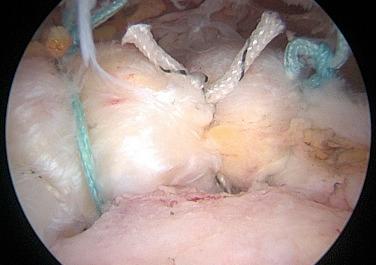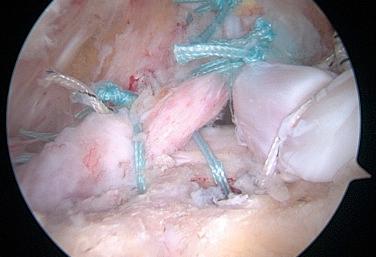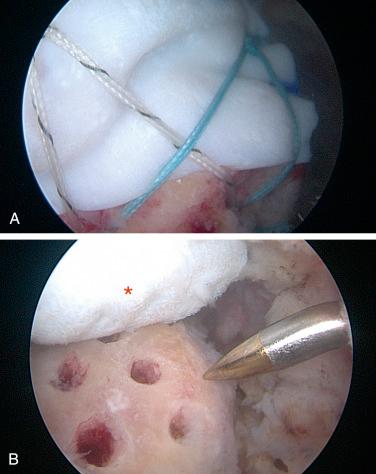Physical Address
304 North Cardinal St.
Dorchester Center, MA 02124
Massive rotator cuff tears have historically been defined as tears that are greater than 5 cm in size in either the anterior-posterior or medial-lateral length, or tears involving at least two tendons. They account for 20% of all cuff tears and 80% of recurrent tears. Reparability is dependent mainly on tendon quality and retraction, muscle atrophy, and fatty infiltration as well as chronicity. Numerous arthroscopic techniques have been described, ranging from partial or complete repair to biologic augmentation, such as use of growth factors, patch graft or marrow-stimulating procedures, or a combination of them. Selection of the most effective treatment for a single patient can be challenging and is based mainly on tear characteristics as well as on the surgeon’s experience and skill set.
Complete repair without excessive tension is the goal of arthroscopic treatment of massive rotator cuff tears. Adequate mobilization and identification of the shape of the tear are the principal surgical steps needed to achieve a successful repair. In case of retracted massive cuff tears, suture anchors are usually placed in a single-row configuration at the articular margin of the humeral head to minimize tension in the repaired tendons. Margin convergence repair is commonly combined with suture anchor repair, based on the tear shape, to further reduce tension in the repair.
Symptom onset: atraumatic (degenerative) or traumatic.
Degenerative tears: pain and limitation in daily activities display a progressive course over time. Patients usually complain of pain and weakness in lifting objects overhead or in taking care of personal hygiene and in other daily activities requiring arm rotation, such as taking a wallet from a back pocket for men or unfastening a bra for women. Night pain is one of the most frequent complaints.
Traumatic tears: sudden pain and functional impairment; patients frequently complain of sudden loss of active range of motion after trauma and intense pain with arm mobilization or during the night.
Patient age: traumatic lesions usually occur in younger individuals, specifically those who are almost 10 years younger than the population affected by degenerative tears.
Mechanism of injury: a fall or a direct trauma to the shoulder. Shoulder dislocation in elderly usually causes a rotator cuff tear rather than capsulolabral injuries.
Inspection of both shoulders in order to detect side-to-side differences: in massive rotator cuff tears, marked muscle atrophy can create deformity of both the supraspinatus and infraspinatus fossae.
Evaluation of passive range of motion: loss of shoulder motion due to posttraumatic joint stiffness or to primary adhesive capsulitis must be ruled out.
Evaluation of active range of motion: pseudoparalysis, defined as the inability to actively elevate the arm beyond 90 degrees with full passive forward flexion and no neurological impairment, is a common finding in traumatic massive cuff tears.
Assessment of scapular kinematics and kinetics: scapula protraction and elevation can be a compensatory mechanism for the loss of active forward flexion.
Subacromial crepitus can be a sign of upper migration of the humeral head and progression to osteoarthritis.
Assessment of muscle strength through specific tests: positive external rotation lag sign as well as drop arm sign and a positive hornblower’s sign are usually indicative of a massive cuff tear.
Involvement of the subscapularis tendon must be assessed with the following specific tests: belly press, lift-off, bear hug, internal rotation resistance at 90 degrees of abduction and external rotation.
Involvement of the long head of the biceps must be assessed with the following specific tests: palm-up and Yergason tests. A typical Popeye deformity can be found in case of biceps rupture.
Neurological examination in order to differentiate weakness due to cuff deficiency from neurological disorders. Presence of paresthesia is usually not related to cuff deficiency.
X-rays: standard anteroposterior view can show upper migration of the humeral head and subsequent reduction of the acromiohumeral interval, which is an indirect sign of massive cuff tear. In revision cases, x-rays can help assess the presence and location of metal hardware.
Ultrasound: this is a low-cost and low-invasiveness imaging tool, but it remains an operator-dependent examination.
Magnetic resonance (MR): this is the gold standard. Tear size is usually assessed on T2-weighted coronal images with the Patte classification, which is based on the number of tendons involved and tendon retraction. Massive cuff tears are commonly retracted to the glenoid. Fatty infiltration according to Fuchs classification is usually assessed on T1-weighted sagittal images. Advanced stages of fatty infiltration usually reflect chronicity of the lesion. Significant muscle atrophy is a common finding in chronic massive cuff tears.
Computed tomography (CT): CT is usually enhanced with contrast agent (CT arthrography) to increase sensitivity and specificity of the examination. It is advisable only in patients who cannot undergo MR imaging.
Magnetic resonance arthrography (MRA): there are no differences between MRA and standard MR imaging in preoperative evaluation of massive cuff tears.
These strategies are usually indicated in patients who cannot undergo surgery because of age and/or multiple comorbidities. Conservative options are daily activity modification, use of nonsteroidal antiinflammatory drugs, subacromial corticosteroids or hyaluronic acid injections, physical modalities, and therapeutic exercises. They are palliative strategies whose aim is to reduce pain with slight functional improvement.
Complete repair: when possible, a watertight complete arthroscopic cuff repair without excessive tension is attempted ( Fig. 25.1 ). Pain reduction, functional recovery, and structural healing of the repaired tendons are the main goals of this operative treatment.

Functional (partial) repair: this is performed when a complete repair is not possible; its aim is to restore function, not anatomy (force couple balancing) ( Fig. 25.2 ).

Biologic augmentation: marrow-stimulating techniques, the use of patch grafts, growth factors, or a combination of these procedures ( Fig. 25.3 ) have recently been suggested as options to enhance tendon-to-bone healing.

Tendon transfers: these are usually indicated in active patients with massive irreparable tears (primary or recurrent). Integrity of subscapularis and teres minor tendons is required to achieve acceptable functional results in posterosuperior tendon transfers, such as latissimus dorsi transfer. Combined anterior and posterosuperior transfer has been described as a salvage procedure, although results are not promising.
Superior capsule reconstruction: this has recently been proposed for cases of irreparable posterosuperior tear; its aim is to recenter the humeral head.
Biceps tenotomy as palliative surgery: the aim of this procedure is pain reduction.
Bony landmarks (drawn on the skin): acromion, scapular spine, distal clavicle, acromioclavicular joint, coracoid apex, and coracoacromial ligament.
Axillary nerve: at risk of injury during lateral portal placement (it lies 5 cm from the lateral tip of the acromion) and during posteroinferior capsular release (strictly connected to the inferior shoulder capsule between 5 and 7 o’clock positions).
Suprascapular nerve: at risk of injury during the posterior portal placement (it lies an average of 1.8 cm [range, 1.4 to 2.5 cm] from the midline of the posterior glenoid) and during mobilization techniques (posterior interval slide).
Musculocutaneous nerve: at risk of injury during anterior portal placement (it arises from the lateral cord of the brachial plexus, medial to the coracoid).
Cephalic vein: it can be damaged during anterior portal placement, leading to a large hematoma.
Acromioclavicular branch of the thoracoacromial artery: at risk during subacromial decompression with release of the coracoacromial ligament (it runs within the ligament, 5 to 8 mm from anterolateral edge of the acromion).
Watertight complete cuff repair: this is the most effective procedure to reduce pain and improve function. Best functional results can be achieved in recent traumatic tears (less than 4 months) in young or middle-aged patients, with fatty infiltration not higher than stage 2 and good-quality tendons, still reducible without excessive tension. Massive cuff tear after shoulder dislocation should also be repaired to improve function and to treat instability symptoms as well. A complete repair can also be attempted in chronic massive degenerative tear with high stage of fatty infiltration if cuff tendons are not retracted beyond the glenoid, albeit that expected functional improvement is less predictable and the risk of retear is the same.
Patch graft augmentation: this is indicated in revision cases or primary massive cuff tear if tendon quality is poor.
Functional (partial) repair: this provides early postoperative patient satisfaction in terms of pain relief and functional recovery, and it is performed when a complete repair is not possible. Reestablishing force couple balance is reasonable to prevent tear progression and subsequent degenerative changes, even if anatomy is not completely restored.
Tendon transfers: these are indicated in massive irreparable tears in young and active patients with no radiological and arthroscopic signs of glenohumeral osteoarthritis.
Superior capsule reconstruction: this is a good alternative to partial repair because it seems to be effective in limiting upper migration of the humeral head.
Biceps tenotomy: palliative surgery for massive irreparable tears in old patients no longer responsive to nonoperative options.
Anesthesia: general or regional with an interscalene block or blended.
Patient positioning: beach chair or lateral decubitus according to the surgeon’s preference. The authors’ preference is to perform rotator cuff repair with the patient in beach chair position.
Arthroscopic tower: this setup is opposite the operative side toward the foot of the table to allow optimal visualization for the surgeon and his/her assistants.
Mayo stand: this contains basic shoulder arthroscopy equipment; the stand is placed opposite the surgeon, over the patient’s knees.
Surgeon: the surgeon stands slightly behind the patient’s shoulder.
Surgical scrub nurse: this person is usually behind the surgeon and the surgeon’s assistants.
Interscalene block allows patient collaboration in patient positioning.
Rotate the operating table 30– 45 degrees to further increase the operative field.
Beach chair position: elevate the patient’s trunk so that the acromion is almost parallel to the floor. This will facilitate the introduction of arthroscopic instruments through the posterior portal.
Five pounds of traction is used to hold the arm in 20–30 degrees of abduction and 50–60 degrees of forward flexion.
Beach chair position in regional anesthesia is not easily tolerated by old patients for long durations. If you estimate that your procedure will take more than 2 hours, general or blended anesthesia should be considered.
Arthroscopic tower containing high-definition flat screen monitor, video camera unit, and light source, irrigation pump, powered instruments, and radiofrequency units.
30-degree scope, shaver, and radiofrequency handpieces, together with inflow and suction tubes, placed on a Mayo stand set up in front of the surgeon.
Syringe (50 mL) for air inspection.
Marking pen to draw bony landmarks.
Hand instruments to create portals: 18-gauge spinal needle, metal cannula, one or two switching sticks, and a portal dilator.
Suture management: plastic cannulas of different calibers, direct and indirect suture passers, suture retrievers, knot pusher, and suture cutter.
Graspers for cuff mobilization and reduction.
Punches and scissors.
Posterior portal: viewing portal or working portal for suture management.
Anterosuperior portal: outflow portal or working portal for powered/radiofrequency instruments and suture management.
Standard lateral portal: viewing portal or working portal for powered/radiofrequency instruments and suture management.
Superior lateral portal: suture anchor placement.
Accessory anterolateral and posterolateral portals can be used to optimize anchor placement and suture management.
Become a Clinical Tree membership for Full access and enjoy Unlimited articles
If you are a member. Log in here